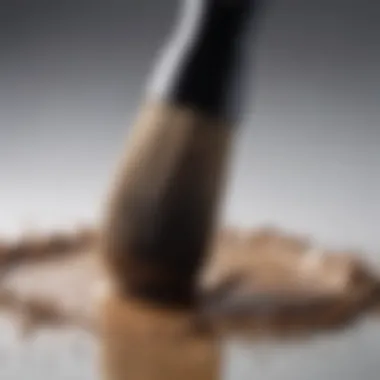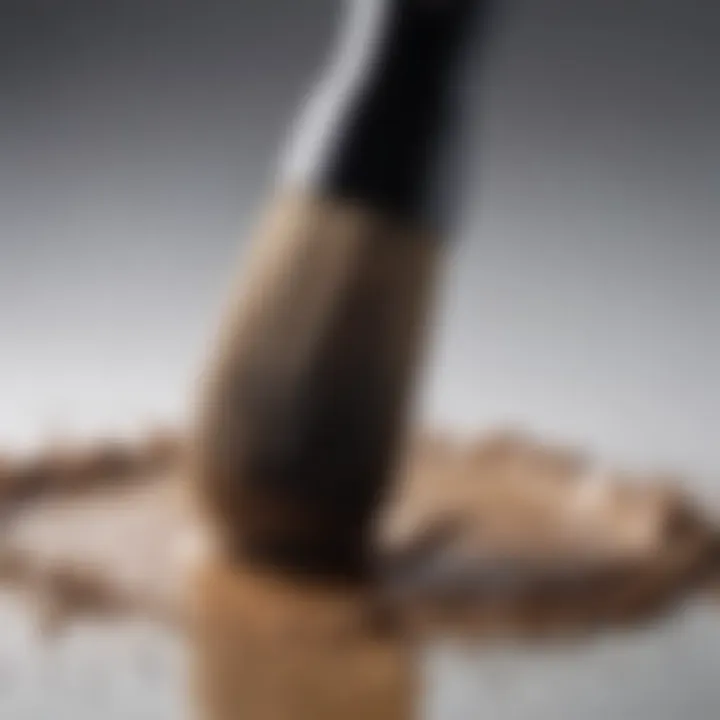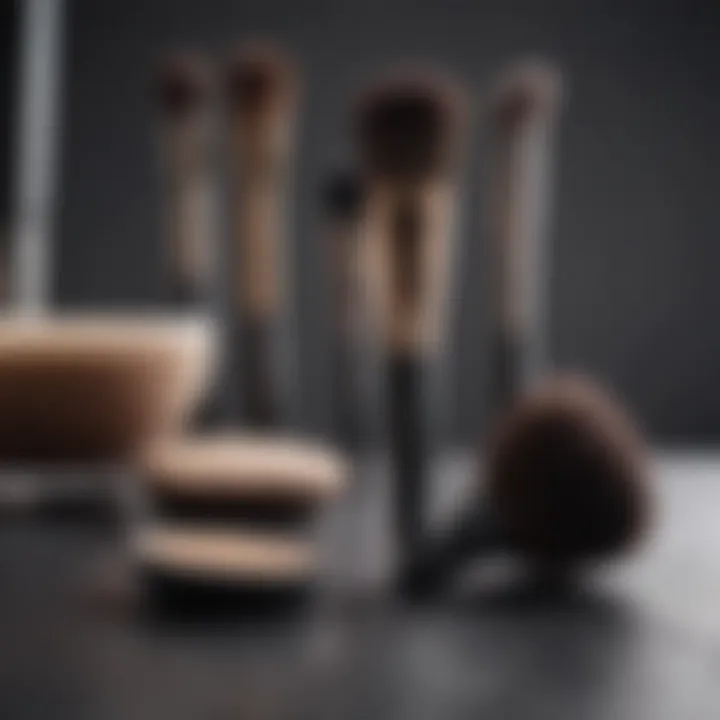A Comprehensive Guide on How to Wash a Makeup Brush


Intro
Keeping makeup brushes clean is a pivotal component of personal hygiene and effective makeup application. Over time, brushes accumulate makeup residue, oils, and bacteria that can contribute to skin problems like breakouts or infections. Thus, understanding the proper methods to wash and care for these tools is essential.
This guide will explore methods for washing various types of brushes, the significance of regular cleaning, the essential tools needed for maintenance, and best practices to prolong the lifespan of these beauty instruments. Furthermore, insights into choosing the correct cleaning agents for different brush materials will be discussed, ensuring your makeup routine remains optimal.
Ultimately, this guide aims to empower readers with the knowledge necessary to elevate their beauty practices. Readers will be equipped with comprehensive and practical advice that promotes healthier skin and improved makeup application skills.
Tips and How-Tos
To maintain your brushes properly, it’s important to use the right techniques and products. Here are some tips for effective brush cleaning:
- Frequency: Clean your brushes at least once a week. Foundation and concealer brushes may need more frequent washes while eye brushes can typically be cleaned bi-weekly.
- Approach: Use a gentle, non-toxic soap or a makeup brush cleaner. Products like Beauty Blender Solid Cleanser or Japonesque Brush Shampoo work effectively.
Steps to Wash Makeup Brushes
- Gather Supplies: You will need lukewarm water, a gentle cleanser, a clean towel, and possibly olive oil for stubborn stains.
- Wet the Bristles: Rinse the bristles under lukewarm water, keeping the ferrule (the metal part) dry to prevent loosening.
- Apply Cleanser: Put a small amount of cleanser on your palm or a plate. Swirl the brush in the cleanser, gently working it through the bristles.
- Rinse: Rinse thoroughly under water until it runs clear.
- Shape and Dry: Shape the bristles back to their original form and lay the brush flat on a clean towel to dry.
"Regular maintenance of brushes is vital for achieving flawless makeup results and safeguarding your skin's health."
Specific Care by Brush Type
Different brushes may require unique care routines. For instance:
- Synthetic Brushes: These are easier to clean, often requiring just soap and water.
- Natural Hair Brushes: These may need special shampoo and conditioner to maintain softness and shape.
The choice of cleaning agent can also impact the cleaning process. Be sure to choose based on the material of your brushes.
Sustainable Practices
Considering environmental impact is crucial in beauty routines. Such practices can also apply to makeup brushes. Here are some actionable sustainable tips:
- Opt for eco-friendly brushes: Brands like EcoTools provide alternatives that use sustainable materials.
- Recycle old brushes: Instead of throwing away old brushes, consider using them for crafts or other applications.
Celebrating Diversity in Beauty
The beauty industry has become more inclusive in recent years. This extends to makeup tools and brushes as well. Recognizing the diverse skin tones and types, many brands now cater to a broader audience. Companies like Fenty Beauty and e.l.f. Cosmetics focus on inclusivity, developing products that resonate with a variety of consumers.
Additionally, cultural influences shape beauty standards and practices around the globe. Understanding how different societies approach makeup application and brush care can enrich one’s own beauty routine and appreciation for diversity.
This comprehensive guide aims to not only help you wash your brushes but also to enhance your beauty journey by appreciating the factors that influence how we view makeup and its tools. Regular maintenance not only provides better results but also underscores a commitment to self-care and hygiene.
Prelude to Makeup Brush Care
Makeup brushes are indispensable tools for anyone who applies cosmetics. However, their maintenance is often overlooked. This section aims to highlight the significance of effectively caring for makeup brushes. Proper care goes beyond aesthetic appeal; it impacts skin health and enhances makeup application. When brushes are clean, they perform better, distributing products evenly and achieving the desired results. Therefore, understanding brush care is an essential aspect of any beauty routine.
The Importance of Cleanliness
Keeping makeup brushes clean is crucial for various reasons. Firstly, cleanliness aids in skin health. Brushes can harbor bacteria, dirt, and oils from prior makeup applications. When these build-up substances come into contact with the skin, they can lead to break-outs or irritation. Furthermore, clean brushes provide a more polished appearance. When brushes are free of debris, they allow for smoother blending and a more professional finish. Regular cleaning is an investment in both personal hygiene and quality of makeup application.
Consequences of Neglect
Failing to clean brushes regularly can lead to several unfortunate consequences. Over time, neglected brushes can become ineffective. Caked-on makeup residues can alter the texture of the brush bristles, making them coarse or stiff. This change can affect how products are applied, leading to unevenness in application or even patchiness. Additionally, the accumulation of bacteria and oils can result in skin issues, such as acne or rashes. In many cases, the investment in quality brushes can be wasted if they are not cared for properly, as their lifespan shortens significantly without regular maintenance. Not to mention, using poorly maintained brushes may deteriorate one's overall makeup experience.
Understanding Different Brush Materials
Understanding the materials used in makeup brushes is essential for proper care and maintenance. Different brushes serve varied functions, and their materials can significantly influence how they should be washed and stored. Choosing brushes made from appropriate materials will ensure better performance, longevity, and an overall improved makeup application experience.
Each type of brush material comes with its own benefits and considerations. For instance, knowing whether a brush is made from synthetic or natural bristles helps define the cleaning methods and tools required. Furthermore, specific brushes may require extra care due to their delicate nature.
Synthetic vs. Natural Bristles


Choosing between synthetic and natural bristles impacts both application and maintenance. Synthetic brushes are usually made from nylon or polyester fibers. These brushes are good at picking up cream products and are easier to clean. They tend to repel water, which makes them less prone to bacteria buildup. This quality allows for a simplified cleaning process, as they can be washed with mild soap and water, and they dry relatively fast.
On the other hand, natural bristle brushes, made from animal hair, offer a softer and more refined application. They are excellent for powder products but require more careful handling during washing. Natural fibers can absorb oils and moisture, making them more susceptible to harboring bacteria if not cleaned properly. A gentle hand when washing them is necessary to maintain their structure and functionality.
In summary, understanding the differences between synthetic and natural bristles will guide you in selecting appropriate cleaning techniques and products, ensuring both hygiene and effective makeup application.
Handling Delicate Brushes
Delicate brushes require special attention. These brushes may include finer tools used for intricate work, such as eyeliner or detail brushes. It is critical to handle them gently to avoid fraying or bending the bristles. The following tips can help preserve their integrity during cleaning:
- Gentle Washing: Use lukewarm water and a mild cleanser. Avoid hot water as it can damage the bristles.
- Minimal Pressure: When cleaning, do not apply too much pressure. Just lightly lather the bristles to remove makeup residue.
- Air Dry: Always lay delicate brushes flat to dry. Hanging them can cause water to seep into the ferrule, loosening the bristles over time.
A careful approach to cleaning delicate brushes is important not only for maintaining their performance but also for extending their lifespan.
"Understanding your brushes can transform your makeup routine from routine to exceptional."
By being mindful of the materials and handling requirements of your brushes, you ensure that they remain in good condition, supporting both your cosmetic application and hygiene needs.
Assessing the Frequency of Cleaning
Understanding how often to clean makeup brushes is crucial for maintaining both hygiene and optimal makeup application. Different brushes serve various purposes, which dictates the frequency of their cleaning. Neglecting this aspect can result in several issues, such as skin irritation, less effective makeup application, and even bacterial growth. Assessing the frequency of cleaning allows one to strike a balance between proper care and brush longevity. Regular upkeep protects the integrity of the brush fibers and ensures a more effective application of makeup products.
Daily Use Brushes
Daily use brushes are those typically employed during your everyday makeup routine. This could include foundation brushes, concealer brushes, and any tools utilized for regular application. Because these brushes are in consistent contact with your skin and various products, they should be cleaned daily or, at the very least, every few days. Doing so helps to minimize the transfer of oils, dirt, and makeup residues onto your skin, which can lead to breakouts and irritation.
When cleaning daily use brushes, consider the following steps:
- Use gentle soap or a specialized brush cleaner to remove buildup effectively.
- Rinse thoroughly to ensure that no residue remains, as this can interfere with subsequent applications.
- Lay the brushes flat to dry, maintaining their shape and protecting the bristles from bending or breaking.
Integrating this cleaning routine into your daily tasks will ensure your brushes stay clean and functional, making your makeup application more efficient.
Occasionally Used Brushes
Occasionally used brushes, such as those for special occasions or specific looks, do not require the same frequency of cleaning as daily use brushes. These tools may include sometimes-used brushes for things like contouring or certain eyeshadow looks. Still, they should be cleaned more frequently than you might assume, perhaps every couple of weeks. If these brushes are used for products that are cream-based or for intense pigments, cleaning them after each use may be prudent to avoid residue buildup.
When assessing how to clean occasionally used brushes, remember this:
- Even though their usage may be less frequent, they still harbor oils and pigments that can degrade their bristles and affect future applications.
- Lightly dampen the bristles and use a gentle cleaner, focusing on the areas with the most buildup.
- Make it a habit to inspect these brushes on a bi-weekly basis, establishing a simple maintenance schedule that prevents future problems.
By recognizing the cleaning needs of your occasionally used brushes, you can maintain their quality, ensuring they remain effective when called upon.
Tools Required for Brush Cleaning
Cleaning makeup brushes requires specific tools to maintain their effectiveness and longevity. Understanding the right tools empowers users to achieve a thorough cleaning process. This section highlights essential elements such as cleaning agents and tools.
Cleaning Agents
Soap Options
Soap options are widely recognized for their role in cleaning makeup brushes. Mild soaps, such as baby shampoo or gentle liquid soap, are ideal for maintaining brush integrity. They efficiently remove makeup residue without damaging the bristles. This gentle approach is beneficial because it preserves the natural oils in the brush. When choosing a soap, consider its pH level. A neutral pH soap helps in avoiding any adverse reactions on the bristles or skin. However, some soaps may not eliminate heavy or waterproof makeup effectively. Therefore, users may need to wash more frequently.
Commercial Brush Cleaners
Commercial brush cleaners are specifically formulated for makeup brushes. They often contain unique ingredients that break down makeup quickly and effectively. This is a significant advantage for those who prioritize swift cleaning. Many popular brands offer options that not only clean but also condition the bristles. Such multifunctionality makes them a popular choice among beauty enthusiasts. However, some commercial cleaners can be relatively expensive compared to traditional soaps. Users should assess their cleaning needs against budget considerations to find the right fit for their routines.
Cleaning Tools
Mats and Gloves
Mats and gloves serve important functions during the cleaning process. Cleaning mats usually have textured surfaces that allow for effective scrubbing of the bristles. They provide a safe environment to clean without the risk of damaging the brushes. Gloves, on the other hand, protect hands from all chemicals used during washing. This protection is crucial, especially for those with sensitive skin.


Handheld Washers
Handheld washers facilitate easy cleaning by providing an efficient method for rinsing and lathering brushes. These devices often come with various settings to tailor pressure and temperature, enhancing the cleaning experience. Their portability is beneficial for users who prefer a quick setup and cleanup. However, not everyone may find the need for this tool essential. Those who prefer traditional methods might skip this option altogether. Ultimately, the choice of tools comes down to personal preference and cleaning habits.
Step-by-Step Guide to Washing Makeup Brushes
Washing makeup brushes is not just a recommendation; it is a necessity for maintaining healthy skin and achieving flawless makeup application. This section details the step-by-step guide to ensure that your brushes are properly cleaned and cared for. Implementing these steps can enhance the longevity of your brushes and ensure they work effectively.
Preparing for Cleaning
Gathering Materials
To effectively clean your makeup brushes, gathering the right materials is integral. You will need:
- Cleaning soap: Mild soap options, like baby shampoo or a gentle dish soap, are good choices since they won't damage the bristles and help remove residues easily.
- Warm water: Always use lukewarm water as it aids in breaking down makeup without harming brush fibers.
- Towel or microfiber cloth: These are used for drying the brushes post-cleaning.
These materials not only contribute to the cleaning process but also ensure that the brushes remain in good condition. A well-prepared setup simplifies the process and minimizes the likelihood of overlooking essential cleaning steps.
Selecting a Workspace
Choosing an appropriate workspace for cleaning your brushes is essential. A clean, flat surface such as a bathroom sink or a kitchen counter works best. This area should be free of clutter and dedicated to the cleaning process, ensuring that you have enough room to maneuver without distractions.
This workspace should also have access to water and proper lighting. Adequate light helps identify any leftover residue on the brush bristles. A clean workspace emphasizes the importance of hygiene, reflecting how you care for your beauty tools and your skin.
Cleaning Techniques for Different Brushes
Foundation Brushes
Foundation brushes play a pivotal role in achieving an even and smooth application of foundation. They usually have dense bristles which can trap makeup and oil. To clean them efficiently, always remember to swirl the brush in the cleaning solution and gently squeeze the bristles to release the product. This technique ensures thorough cleaning without damaging bristles that can lead to shedding.
Eyeshadow Brushes
Eyeshadow brushes come in various shapes and sizes, each designed for a specific purpose. It is crucial to use a gentle technique when cleaning them. A simple back-and-forth motion on a clean surface, combined with a gentle lather with your cleaning agent, works well. It helps remove pigments while preserving the fine tip necessary for detailed application.
Blush Brushes
Blush brushes often collect powder and oils, leading to a buildup that affects application. Rinse the bristles under running water and apply your cleaning agent, using a gentle circular motion to work it into the bristles. Ensuring that you rinse thoroughly is critical to remove all soap residue, which can irritate the skin upon application.
Drying and Storing Brushes
Drying and storing your brushes properly is a crucial step that often gets overlooked. After cleaning, reshape the bristles back to their original form and lay them flat on a towel to dry. Avoid standing them upright as water can seep into the ferrule and loosen the glue holding the bristles.
Storing them correctly prevents deformation of bristles. A dedicated brush holder or a clean drawer that allows the bristles to breathe will prolong their life. Proper care and drying techniques are essential to maintain the structure and functionality of your brushes.
Common Mistakes to Avoid
Proper cleaning of makeup brushes can transform your beauty routine, yet many make mistakes that ultimately undermine their efforts. Recognizing these common errors is crucial for maintaining brush hygiene and performance. Understanding the pitfalls ensures you maximize the lifespan of your brushes and your investment in them. By avoiding these mistakes, you can not only enhance your application skills but also support your skin health, making this section essential for all users.
Over-washing
One prevalent misconception is that frequently washing brushes is always better. While regular cleaning is important, over-washing can lead to damage. Natural bristles can become brittle, losing their ability to hold product effectively. This wear and tear drastically alters the texture and application of the brush. It can be tempting to wash brushes every day, especially when they appear dirty, but a more balanced approach is recommended.
To effectively manage your brush care, consider the following:
- Frequency: Aim to wash your brushes thoroughly once a week. Spot cleaning can be done midweek to ensure ongoing hygiene without the harshness of frequent deep washes.
- Assessment: Evaluate the brushes after each use. If there’s minimal product residue, you might skip a deep clean. However, brushes used for creamy products like foundation may require more immediate attention.
- Air Drying: After each clean, let brushes air dry completely before use. This also helps maintain their structure and prevents mold growth.
Over-washing can lead to more frequent need for replacements, affecting both your budget and your beauty routine. Recognizing the signs of when your brushes truly need washing is a step towards healthier habits in makeup application.
Using Harsh Chemicals
Another common error lies in the cleaning agents chosen for washing makeup brushes. While strong soaps may seem effective for cutting through makeup residues, they often strip bristles of their natural oils. This can impact both the performance and longevity of your brushes.


Instead of opting for abrasive cleaners, consider these alternatives:
- Gentle Soaps: Use mild dish soap or baby shampoo diluted with water to clean brushes. These options are effective but not damaging.
- Natural Alternatives: Some users find success with natural solutions, like olive oil mixed with vinegar. This approach can clean while conditioning the bristles.
- Commercial Cleaners: If you prefer convenience, look for designated brush cleaning products that are pH balanced. These are specifically designed not to damage the bristles.
It’s important to read the labels of cleaning agents. Harsh chemicals can irritate skin, especially for those who may be sensitive. Opting for gentler options not only preserves bristles but also protects your skin from potential irritants.
Key Takeaway: Avoid over-washing and harsh cleaners to maintain healthy, effective brushes. Your skin will thank you too.
Signs Your Brushes Need Cleaning
Recognizing when your makeup brushes need cleaning is vital for maintaining both hygiene and makeup performance. Brushes can accumulate dirt, oils, and product residue over time, which can lead to skin irritations and less effective application techniques. Ignoring these signs not only affects makeup quality, but it can also pose a risk to your skin health. In this section, we will explore two primary indicators that your brushes require immediate attention: visual cues and performance issues.
Visual Cues
Visual signs are often the first indication that your makeup brushes need a thorough wash. Take a moment to inspect your brushes regularly. If you notice any of the following signs, it's time to take action:
- Discoloration: Brushes that have changed color from their original state, especially around the bristle areas, may indicate a buildup of product.
- Residue Build-Up: Visible residue or flaky makeup products should signal the need for cleaning. The residue can also interfere with the effectiveness of the brush.
- Bad Odor: If you detect an unpleasant smell emanating from your brushes, it’s a clear sign of dirt and bacteria accumulating on the bristles.
These visual cues serve as a reminder that cleanliness is crucial. When brushes are maintained regularly, they perform better and last longer, providing optimal results during makeup application.
Performance Issues
Performance issues are another key indicator that your brushes are overdue for a cleaning. If you observe any of the following, it's important to address the problem swiftly:
- Uneven Application: If foundation, blush, or eyeshadow does not blend smoothly, it could be due to product buildup on the bristles.
- Stiff or Hard Brush Bristles: Brushes that feel rigid may have accumulated dried product and are less effective at applying makeup.
- Increased Skin Irritation: If you experience breakouts or redness after using a certain brush, check if it is clean. An unwashed brush can harbor bacteria that irritate the skin.
Recognizing these performance issues is as important as noticing visual signs. Keeping your brushes clean can enhance their effectiveness and contribute to a more flattering makeup look. Regular cleaning ensures that you are not just putting makeup on your face but applying it with tools that are in their best possible condition.
"Investing time in maintaining your brushes can improve your overall makeup experience and safeguard your skin health."
By being attentive to both visual cues and performance issues, you can maintain the longevity of your brushes and ensure that they continue to serve you well.
Tips for Maintaining Brush Health
Maintaining the health of your makeup brushes goes beyond simply washing them. It is essential to consider various aspects that contribute to their longevity and performance. Regular brush care minimizes the risk of bacterial growth and ensures that each application delivers flawless results. When brushes are kept clean and in good shape, their bristles remain effective, leading to smoother makeup application. Plus, proper maintenance reduces the frequency with which brushes must be replaced, making it a cost-effective practice in the long run.
Regular Maintenance Tips
Incorporating simple habits into your beauty routine can significantly enhance the lifespan of your brushes. Start by rinsing your brushes after each use, even if you don’t perform a full wash. Just a quick rinse can clear away some residue. Use a gentle soap to fully clean the brushes at least once a week. For brushes used with liquids or creams, an even more frequent washing schedule may be necessary.
Use a sponge or a textured mat to help remove makeup more effectively. After cleaning, don't forget to reshape the bristles to maintain their original form. Try to keep the handles and ferrules dry to prevent damage over time. Additionally, avoid using extremely hot water, as it can affect the adhesive that holds the bristles in place.
Storing Brushes Properly
Proper storage of brushes is just as critical as regular cleaning. Avoid placing them in a drawer loose, where the bristles can become misshapen or damaged. Instead, keep your brushes upright in a holder to maintain their shape. If you must store them flat, consider wrapping them in a protective cloth.
Always ensure brushes are fully dry before placing them in storage. This prevents mold growth and preserves the integrity of the bristles. It’s best to store brushes in a cool environment away from direct sunlight, which can degrade materials over time.
Remember, taking the time to maintain brush health pays off, granting you the efficiency and performance needed in your daily makeup application.
"A well-maintained brush is a guarantee of a flawless makeup application."
By following these guidelines, you can ensure your brushes remain in optimal condition. Regular and mindful maintenance leads to better performance and a more enjoyable makeup experience.
The End
The conclusion serves as a crucial part of this article, synthesizing the insights and practices discussed throughout. The emphasis on cleanliness in makeup brushes cannot be overstated. Regular cleaning not only prevents the buildup of bacteria but also enhances the performance of brushes, which in return elevates makeup application.
Recap of Key Practices
In summary, maintaining brushes requires a few key practices:
- Understanding Brush Types: Different materials and shapes dictate varying cleaning methods. Natural brushes may need gentler care compared to synthetic ones.
- Regular Cleaning Schedule: Establishing a routine for cleaning based on brush usage can prevent makeup mishaps. Daily brushes might need more attention than those used occasionally.
- Proper Tools: Utilizing appropriate cleaning agents and tools will ensure longevity. Gentle soaps or specialized brush cleaners are recommended.
- Thorough Drying: After washing, brushes should be dried properly to avoid damage. Positioning them horizontally while drying prevents water from seeping into the ferrule.
Encouragement for Systematic Care
Systematic care of makeup brushes is not merely a suggestion but a necessity. Women of all ages should make brush cleaning an integral part of their beauty routine. The positive impact on skin health and makeup quality is substantial. By committing to regular cleaning, users can avoid skin irritations and achieve a flawless look.







